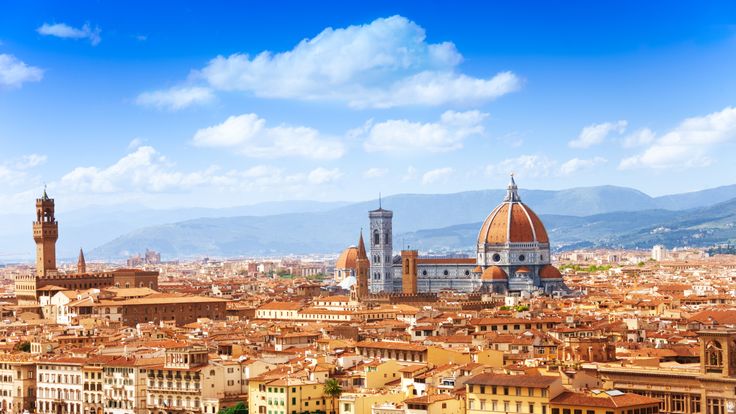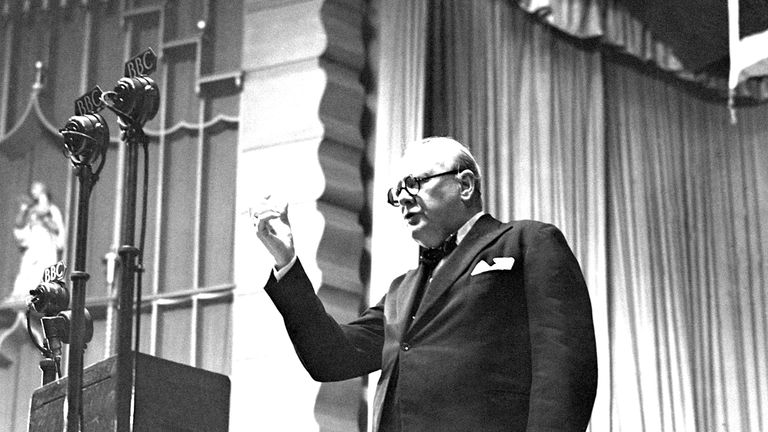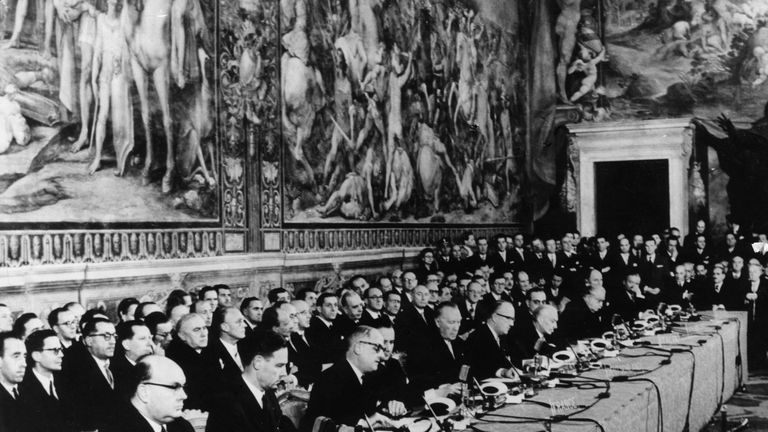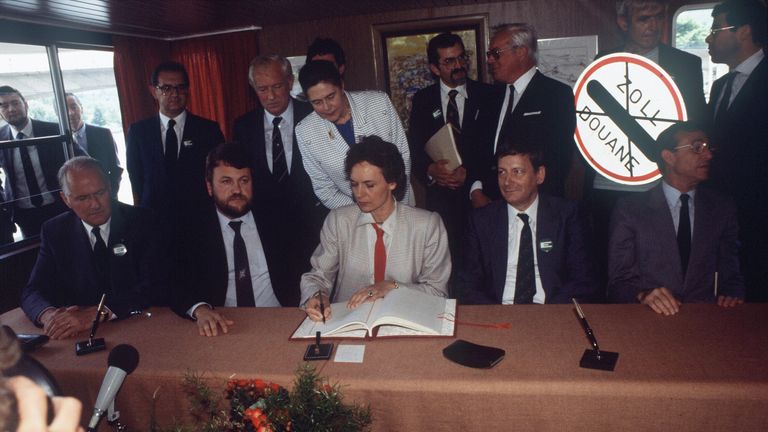Will Florence join list of cities that have defined the EU's history?

Friday 22 September 2017 14:33, UK
Greg Heffer, Political Reporter
After Theresa May delivered a major speech on Brexit in Florence, will the Italian city add its name to the list of European locations that have forged their place in the history of the European Union?
Just weeks after the Second World War finally ended, Britain's wartime leader Sir Winston Churchill delivered a speech at the University of Zurich in Switzerland.
In order to prevent European nations once again going to war, he called for "a kind of United States of Europe", which some claim makes him one of the forefathers of European integration.
The speech has subsequently become the subject of feverish debate over whether Sir Winston Churchill would have supported the later creation of the European Union, or indeed Brexit.
Others argue he used his Zurich speech to stress the need for Franco-German integration after the Second World War, but that his words also suggest he did not want Britain to become part of his proposed "United States of Europe".
The French capital can claim to be the birthplace of European integration, with the 1951 Treaty of Paris establishing the European Coal and Steel Community (ECSC), the eventual forerunner of today's EU.
The agreement began to bind Europe's nations together economically and was signed by Belgium, France, West Germany, Italy, Luxembourg and the Netherlands.
The same nations who created the ECSC went one step further when they gathered in the Italian capital six years later to sign one of the two most important treaties in the history of the EU.
The Treaty of Rome set up the European Economic Community (EEC), deepening economic integration with the "common market" and a customs union, while it also established the European Atomic Energy Community (Euratom) to govern the peaceful use of nuclear energy.
Proposals for a Common Agricultural Policy, Common Transport Policy and European Social Fund were also included, while it additionally set up what would become today's European Commission.
The Merger Treaty in 1965, signed in the Belgian capital, created a single Commission and single Council to oversee the three European Communities that existed at the time - the EEC, Euratom and ECSC.
It also helped cement Brussels' position as the home of the Commission and Council, where most of the EU's infrastructure is still located today.
Situated on the border of three European countries, the small wine-making village of Schengen has lent its name to one of the EU's signature policies.
Signed in 1985 onboard a boat on the River Moselle, the Schengen Agreement abolished many of Europe's internal borders to enable today's passport-free travel across the majority of the continent.
Belgium, France, West Germany, Luxembourg and the Netherlands were the first signatories, who have since been joined by another 21 countries.
However, Europe's migration crisis saw a number of nations reintroduce border controls in 2016, many of which are still in operation.
In 1988, Britain's prime minister Margaret Thatcher used an explosive speech to the College of Europe in Bruges to rail against the European Commission's push towards federalism under Jacques Delors.
She warned: "We have not successfully rolled back the frontiers of the state in Britain, only to see them re-imposed at a European level with a European super-state exercising a new dominance from Brussels."
Her remarks are often viewed as an inspiration for eurosceptics, of whom many later rallied behind the Bruges Group think tank - named in tribute to Thatcher's speech.
Thatcher's intervention complicated the UK's relationship with Europe and heightened tensions within her government, which was later to lead to her downfall.
Signed in 1992, the treaty signed in the Dutch city of Maastricht proved to be one of the most controversial in the EU's history.
The Maastricht Treaty, officially known as the Treaty on European Union, established the EU and laid the foundations for the euro single currency.
It also significantly expanded European integration with the creation of EU citizenship, beginning the bloc's principle of freedom of movement, as well as furthering cooperation on foreign and security policies and police and judiciary matters.
Twelve countries, including Britain, signed the treaty, but its passage was marked by a number of national battles to secure agreement.
Denmark was forced to hold a second referendum before its population ratified the treaty, while a national vote in France only narrowly supported it.
In the UK, prime minister John Major suffered a series of gruelling battles with Conservative eurosceptics in Parliament, which came close to bringing down his government.
British opposition to Maastricht spawned a number of eurosceptic groups, including the forerunner to the UK Independence Party (UKIP).
The 1997 Amsterdam Treaty sought to update and clarify the Maastricht Treaty of five years before, as well as prepare the EU for enlargement into eastern Europe.
It incorporated the Schengen Agreement into EU law for all member states except Britain and Ireland, aimed to make the bloc more democratic, established cooperation on asylum and immigration, and boosted integration on police and law enforcement.
New prime minister Tony Blair also dropped the UK's opt-out on the EU's social chapter, which had been in place at Maastricht.
After the failed attempt to establish a European Constitution, which was rejected by French and Dutch voters, the Lisbon Treaty was signed in the Portuguese capital in 2007.
It included many of the changes the European Constitution sought to introduce, such as establishing the position of a president of the European Council; new powers for the European Commission, European Parliament and European Court of Justice; and the removal of national vetoes in a number of areas.
It was designed as an attempt to improve the functioning of the EU since its enlargement, but critics viewed the agreement as a further march towards European federalism.
Ratification of the Lisbon Treaty was delayed when Irish voters rejected it at a first referendum, before the decision was reversed in a second national vote.
Theresa May headed to the city of the Renaissance hoping for a rebirth in the UK's relationship with the EU, following last year's Brexit vote.
With divorce negotiations having stalled over the issue of an exit bill, the Prime Minister hoped to ease the impasse with one of the most important speeches of her life.












